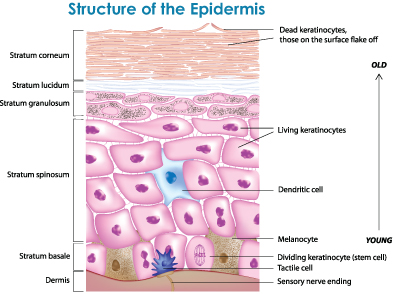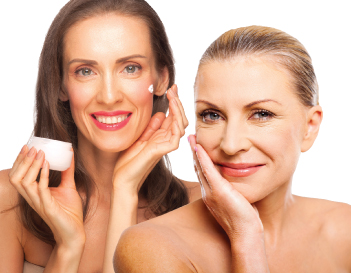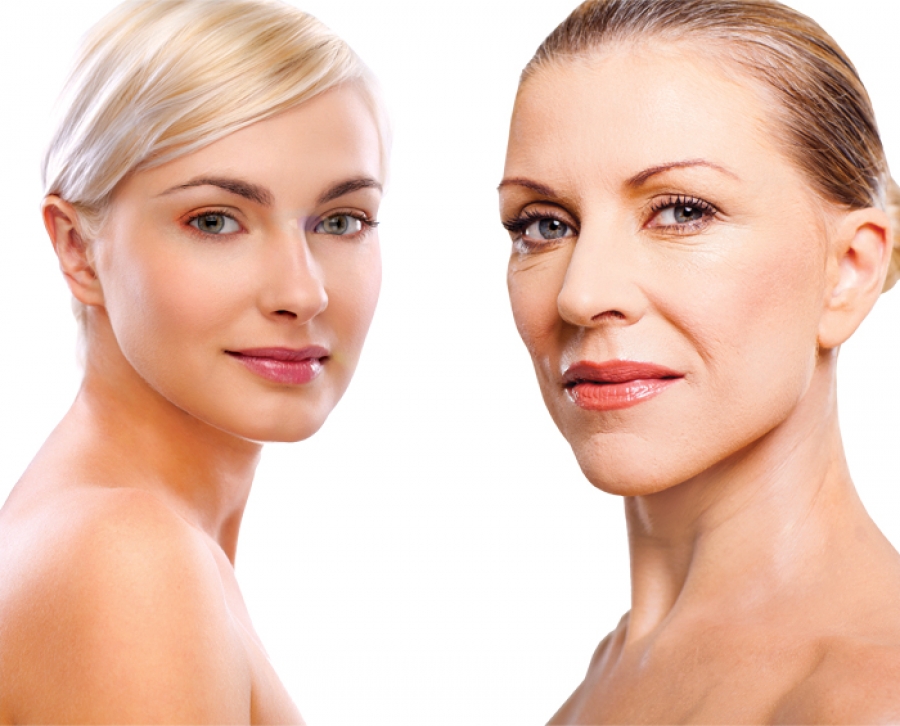Educating clients about the factors that contribute to the visible signs of aging increases their compliance and ultimate success with the customized treatment protocols and regimens you recommend. An in-depth understanding of how the skin ages both intrinsically and extrinsically, as well as how the manifestations of visible aging differ throughout the decades, is highly beneficial to effective treatment. It is also useful to set realistic expectations with each patient and make certain they feel empowered to play an integral role in their own skin improvement.
 How Skin Ages
How Skin Ages
The skin is a dynamic organ made up of the epidermis, dermis and subcutaneous adipose tissue. Each layer is affected and changes differently in response to aging. The epidermis is the outermost layer of skin, which is made up of the following layers: basal, spinous, granulat, clear and cornified.
Basal layer (stratum basale) – this layer is made up of keratinocytes that undergo cell division and are responsible for growth of the epidermis. Also contained within this layer are melanocytes that produce pigment to protect the cells from the ultraviolet (UV) rays of the sun.
Spinous layer (stratum spinosum) – composed of multiple layers of square-shaped cells and desmosomes which hold these cells together. This layer also encompasses Langerhans cells that assist in the skin's immune function.
Granular layer (stratum granulosum) – consists of dying cells that contain distinct granules.
Clear layer (stratum lucidum) – a barrier composed of transparent cells through which light can pass. These cells are only present in thick skin, such as the palms of the hands and soles of the feet.
Cornified layer (stratum corneum) – composed of tightly packed dead cells, which are constantly being shed and replaced. The stratum corneum also contains the skin's natural moisturizing factor (NMF) and is responsible for maintaining skin hydration. As the skin ages, and as a result of environmental insults, this natural barrier function becomes compromised, leading to dry and dehydrated skin. The process of desquamation is also slowed due to extrinsic factors as the skin ages, contributing to a dull complexion.
The dermis is the layer largely responsible for the skin's tone, elasticity and overall firm and youthful appearance. It is comprised mostly of the extracellular matrix (ECM), which is an interconnected network of molecules and proteins that dictate the structure, tightness and thickness of the skin. Among the components of the ECM are collagen (which determines shape, strength and resiliency) and elastin (which allows the skin to stretch and contract).
In addition to collagen and elastin, the ECM contains the adhesive proteins fibronectin and laminins, as well as glycosaminoglycans (GAG), such as hyaluronic acid, which can hold up to 1,000 times its weight in water. GAGs surround the ECM and absorb water, which helps the skin maintain a plump and healthy appearance. Due to time, UV exposure, and other external insults, this neatly organized structure becomes one with elastic fibers that no longer spring back into shape, cross-linked collagen fibers and a reduced GAG content. This will worsen naturally as the patient becomes older, yet there are therapies that can be implemented to help prevent its demise.
The subcutaneous layer is the lowest layer, made up of fat and connective tissues. Contained in this layer are larger blood vessels that help regulate heat, in addition to an extensive network of nerves and sudoriferous glands. The subcutaneous layer helps skin maintain its plump and taut outer appearance. However, this layer is diminished as one ages, which leads to lost facial volume, wrinkling and laxity.
Intrinsic Versus Extrinsic Causes of Aging
Cutaneous aging is a result of both intrinsic and extrinsic causes. Although there is little one can do about their genetics, avoidance of the known extrinsic causes of aging is an excellent way to mitigate visible signs of aging. Scientific research suggests that up to 90 percent of visible signs of aging are due to extrinsic factors.
Intrinsic Aging Factors
A portion of how we age is based on our genetics. DNA and gene expression play a large role in the appearance and durability of skin over a lifetime. The study of genomics provides a framework for understanding how the thousands of human genes are regulated, or expressed, in relation to both internal and external stimulation. This includes genes that regulate factors such as skin pigment, how the various layers of the skin communicates, and the speed at which cell turnover occurs.
Racial heritage also contributes to the rate and way in which the skin ages. Some ethnic groups, especially those in equatorial regions, possess thicker skin that is slower to show the signs of aging, while other groups who originate from colder climates have thinner skin that is more prone to vascular manifestations, wrinkling and dryness over the years.
The climate and strength of the sun in particular geographic locations will affect the makeup of the skin over generations and how that particular group will age over time. The widely recognized Fitzpatrick Scale, developed in 1975 by Harvard University Dermatologist Thomas Fitzpatrick, classifies the range of skin tones that a skin care professional will encounter in their practice. In the Fitzpatrick Scale, clients are assigned a number value ranging from one to six (with one being the lightest and six the darkest) based on the color of their skin. For each general pigment classification, there are documented corresponding characteristics. However, this method does not account for the fact that many individuals are of mixed heritage and although they may appear to have the classic skin tone of one ethnicity or region, they may in fact have close relatives with a completely different skin tone, indicative of a heritage and skin type that may not fit neatly into one of Fitzpatrick's classifications.
The Global Heritage Model expands on Fitzpatrick's classifications by assigning characteristics based on the client's geographical ancestry and predicting the probability of the client developing post-inflammatory hyperpigmentation (PIH) and potentially skin cancer. The model fundamentally divides individuals into two groups – equatorial and polar. Those who fall into the equatorial group (regions with intense UV activity) have more responsive melanocytes and tend to experience more incidences of PIH, while the polar group (regions with minimal UV intensity) possess less responsive melanocytes and typically lighter eyes, hair and skin. These are important factors to take into consideration when evaluating the aging process of your patients and developing heritage appropriate treatment protocols, regardless of age.
"Almost everyone can benefit from preventative and restorative anti-aging skin care, yet the strategies for treating the skin of clients in their 30s versus clients in their 70s are quite different."
Extrinsic Aging Factors
While intrinsic factors play a part in how we age, volumes of research have demonstrated that external factors play a much larger role. While each person may have genetic predispositions, lifestyle choices and external environmental factors contribute much more significantly to the rate in which the skin ages. With advancing age, the visible manifestations of these extrinsic offenders become more obvious. The treatment strategies that are implemented must be more aggressive in an older patient.
It is well known that the sun's UV rays are the top contributor to the visible signs of aging. Conditions such as skin laxity, collagen degradation and hyperpigmentation are all a result of UV exposure. UVA rays are the furthest reaching of the sun's rays and are present throughout the year. Many people assume that the risks associated with UV damage are only present in the summer, but UVA rays are also strong in winter and can penetrate clouds and glass. UVB rays, on the other hand, are shorter and tend to promote more superficial damage in the uppermost layers of skin. The development of skin cancer can be instigated by much smaller doses of UVB rays than UVA, with sunburn and peeling often being the first steps in that process.
Smoking is one of the major external causes of premature skin aging, perhaps second only to sun exposure. Despite the health and aging risks, however, The Campaign for Tobacco Free Kids has documented that smoking is a habit of approximately 50 million Americans, including 3.4 million high school students. While the effect of smoking on the lungs and cardiovascular systems is widely known, most people do not consider the cosmetic and health ramifications for their skin. In fact, smoking tobacco accelerates the aging process considerably including the formation of deep lines and wrinkles, skin discolorations, ECM breakdown, abnormal skin growths and slowed wound healing.
Diet also plays a considerable role in the health of one's skin. At the most basic level, we are made up of trillions of cells, all of which require nourishment in order to thrive. While topical treatments can assist in maintaining youthful skin, a myriad of vitamins, proteins and other nutrients nourish the skin on a cellular level and contribute to the overall health of the skin throughout its life cycle. Poor diet over many decades can contribute to the severity of visible skin aging. Educating younger patients to embrace a healthier lifestyle early on will help reduce the visible impact later in life.
Common Components of Visible Skin Aging
Topical cosmeceuticals are typically formulated to address specific age-related skin challenges. To develop effective treatment strategies for treating younger and older patients alike, the following concerns must be assessed and addressed: ECM degradation, textural variances and dyschromias.
Matrix degradation is largely due to the oxidative stress and matrix metalloproteinase (MMP) upregulation that results from UV exposure. The younger a patient is when they seek treatment, the less structural damage will have occurred, making improvement and reversal far easier. Treatment outcomes for patients in their 30s are highly successful. With each passing decade, there will be damage incurred that can only be rectified by surgical means. Certainly, much improvement can be experienced with targeted daily care regimens and regular superficial blended chemical peels for all age groups, but outcomes will be more restricted and less dramatic than those experienced by patients in their 30s, 40s and even 50s. Although many clients in their 70s are happy with improvement on any level, standards have been raised and many patients in their 70s are still living extremely full and active lives.
Another important component of facial aging is lost volume. Resulting from resorption of facial bones and the atrophy of adipose tissue, facial volume is a visible indicator of age. Daily application of broad spectrum sun protection, the use of vitamin and peptide topicals, and regular superficial peels will help clients of any age repair existing damage and limit any continued injury to the structural components of the skin. Patients with more advanced degradation may need to turn to injectable fillers that either create immediate fullness or stimulate the deposition of more collagen within the skin, creating a fuller, more youthful appearance.
Textural Variances
The texture of the skin's surface is another key indicator of a patient's age and lifestyle choices. Varying degrees of dryness, dehydration, coarsening and epidermal keratinization are hallmarks of aged skin.
An age-related decrease in the stratum corneum's NMF reduces barrier function, increases transepidermal water loss (TEWL), and accentuates fine lines. Additionally, the process of desquamation slows with time and with exposure to the elements – from the normal cycle of approximately every 28 days to as much as every 55 days in aged skin – allowing the flattened corneocytes to build up, making the skin appear dry, flaky and coarse.
Aged keratinocytes are more resistant to the natural process of cell death, so older skin tends to be more prone to DNA damage and the development of skin cancer. In addition, patients who have experienced extended sun exposure over their lifetime may develop solar elastosis, a deposition of large amounts of abnormal elastic material that replaces the more normal collagen-rich ECM. Solar elastosis appears as a thickening of the skin that can lead to a yellow tone and a leather-like appearance.
"Conducting a thorough patient analysis and identifying prominent and contributing genetic, racial and geographical parameters can help you develop appropriate treatment plans for all your patients."
Clearly these textural issues will be exacerbated over time, so more dramatic outcomes may be achieved the earlier the clinician's intervention begins. Positive results can still be achieved with older patients, but more time, a variety of treatments and topicals will typically be necessary. Alpha hydroxy acids, mechanical exfoliants, humectants and occlusives all help to improve the texture and appearance of aging skin.
Dyschromias are a hallmark of extrinsically aged skin. This can range from diffuse redness and a mottled skin tone to obvious hyperpigmented lesions. An easily apparent and common sign of aged skin is a visibly mottled and uneven skin tone. These dyschromias are due to a degeneration of the vascular system and melanogenesis. Both blood and melanin-related discolorations are intensified by UV exposure and are more apparent in highly photodamaged patients due to the thinning of skin. Pigment-related dyschromias are much more easily treated than those related to vascular degeneration so treatment pathways for younger patients addressing dyschromias can be much more straightforward.
Cosmeceuticals can assist with vascular dyschromias by protecting and promoting the collagen around damaged vessels and by limiting inflammation and dilation. Sun avoidance and daily broad spectrum protection are critical and can also help to mitigate vascular changes. Once facial telangiectasias have developed, however, there are no great cosmeceutical options for their resolution. Use of laser therapy for their removal is recommended.
Pigment-related dyschromias are a result of UV exposure, hormonal shifts and trauma. The process of melanogenesis is comprised of many interconnected reactions, providing multiple opportunities to interrupt melanin production through the use of a variety of proven over-the-counter and cosmeceutical ingredients. The use of several topical pigment-reducing ingredients with different mechanisms of action typically leads to accelerated results compared to the use of a single tyrosinase inhibitor. A few of the beneficial ingredients include hydroquinone (HQ), kojic acid, lactic acid, retinoids, azelaic acid, arbutin, resorcinol derivatives and undecylenoyl phenylalanine.
 Areas of Concentration Through the Decades
Areas of Concentration Through the Decades
There are some skin health efforts that carry equal weight regardless of age. However, there are specific skin concerns which garner more attention during particular decades of the aging process. Here is an overview of these target areas:
30s – Eye Area
The first signs of visible aging generally begins to appear in the 30s. Fine lines, particularly around the eye area, become more apparent. These lines, or crow's feet, are brought on by a number of factors including facial expressions, environmental pollutants and UV exposure. Daily use of a broad spectrum sunscreen with a SPF of at least 30 that contains at least one UVA blocker (zinc oxide, titanium dioxide, avobenzone or ecamsule) is essential to every daily skin care regimen. Additionally, antioxidant ingredients like tocopherol or tocopheryl acetate (vitamin E), ascorbic acid (vitamin C), panthenol (vitamin B-5), glutathione or EGCG (from green tea) should be added to the clients' daily regimen in order to prevent and reverse free radical damage and also help increase UV protection.
The best ingredients to incorporate at this age include retinol, which builds collagen and protects it from breakdown, increasing cell turnover to reveal younger-looking skin; ascorbic acid, which also builds collagen and prevents inflammation and oxidation that accelerates visible aging; and certain peptides that are also important additions, as some help inhibit repetitive motions (like squinting) that contribute to crow's feet around the eyes, while others stimulate the deposition of collagen to lessen the appearance of fine lines.
40s – Reversing Sun Damage
By age 40, damage from prior years becomes increasingly apparent. Fine lines, discolorations and a coarse surface texture are common and directly linked to overexposure. The reversal process is a bit more in-depth and often requires more products for fast results. Ascorbic acid and retinol, essential for clients in their 30s, are just as important, if not more so, for treatment of sun damage in the 40s. Collagen-building peptides are excellent additions to a regimen to reduce wrinkling. Hydroquinone, kojic acid, arbutin and undecylenol phenylalanine are all important for reducing skin discolorations. Products containing blends of skin brighteners typically deliver the fastest results. Lastly, broad spectrum sunscreen with an SPF of at least 30 must be used daily to shield the skin from further UV exposure and damage.
50s – Sensitive Skin/Peels
As the skin ages, it loses essential moisturizing components. This lack of moisture, in conjunction with overuse of aggressive products throughout one's life, often leads to sensitivities. Harsh climates and products like at-home chemical peels, nut-based scrubs and alkaline (soap) cleansers can disrupt the skin's barrier, causing an inability for the skin to retain its critical NMF. Rebuilding this barrier, while also gently treating the visible signs of aging, is possible. The first step is to cease the use of any products or treatments that could exacerbate the problem (for example, soap, harsh scrubs, et cetera). It is also essential to include a high quality moisturizer in the regimens of clients in this age group. Well-formulated hydrators contain both humectants that attract moisture to the skin and occlusives that work to retain that moisture within the skin. Humectant agents include glycerin, urea, sodium PCA and hyaluronic acid. Occlusives are ingredients such as shea butter, niacinamide and dimethicone. Replenishing the surface of the skin with phospholipids and ceramides is also helpful in boosting barrier function.
Once the barrier is repaired, retinol and peptides should be introduced to reduce wrinkling, laxity and discoloration. Superficial blended chemical peels are another option to deliver more dramatic outcomes and also to enhance topical ingredient penetration. Superficial chemical peels that contain blends of acids such as TCA and lactic acid in conjunction with melanogenesis inhibitors like kojic acid, hydroquinone and arbutin can help take a patient's results to the next level. These blended peels help produce excellent visible improvement without the downtime associated with deeper, straight acid chemical peels. Utilizing these treatments will help prolong or eliminate the need for more invasive treatments later in life.
 60s and 70s – Anti-Aging
60s and 70s – Anti-Aging
By the 60s, the skin's support structure stops rebuilding the way it once did. Collagen and elastin production slows down considerably and the skin begins to thin. Cell turnover rates slow, leading to buildup and a dull complexion. For home use, beaded exfoliants are a good choice. It is important that the particles used are round, smooth beads and not jagged nut pits that can damage skin and lead to inflammation. Periodic use of gentle exfoliants will loosen dead skin cells, revealing the new cells beneath. As with virtually all skin concerns, retinol is also imperative due to its ability to increase the cellular turnover rate, while also acting as an antioxidant and collagen and elastin builder. Antioxidants and sunscreens will also assist in the process by protecting against further damage.
Once patients have reached a more advanced age, a multi-step approach with combined treatment options is typically the best approach. Some patients should also consider hyaluronic acid fillers or poly-L-lactic acid injectable treatments to build volume in the face and ultimately smooth the surface of the skin.
As we know, age is truly just a number. Many factors go into the treatment of any client. Older clients who have avoided unnecessary sun exposure and used sunscreens and high quality skin care products for the majority of their lives will have skin in far better condition than a 40 year old client who regularly tans and does not use any topical to lessen or correct damage.
Marketing for Different Age Groups
The anti-aging market is extremely lucrative, though it is one that is teeming with grand promises and misinformation. Marketers are well aware that, as a society, we have become obsessed with youth and use appearance to judge an individual in any number of situations. It is the responsibility of formulators and marketers to accurately and realistically describe the expected outcomes from a product's use. This allows consumers to make informed choices for their personal health and well-being. Additionally, this type of marketing integrity places the company in a favorable light with customers who are becoming increasingly adept at avoiding claims and recommendations that are not science based.
To ensure business success, effective and truthful marketing is necessary in order to make certain that clients can identify the correct products and instill confidence in them that the recommendations being made by their skin care clinician are correct. To that end, it is important to structure your marketing outreach efforts in such a way that you are addressing the needs of your target market. When it comes to skin health and anti-aging, prospective customers will have distinctly different interests and needs based on their particular age group. When seeking solutions to combat aging, people will most often fall into the following categories: preventative, moderate correction or restoration.
Preventative (ages 15 to 30) – When marketing to this group, the primary focus should be on cleansing, beauty enhancement, UV protection and preventing early signs of aging. Products that will be most sought after are those that reduce oil, exfoliate, moisturize and tone. The primary focus should be on protection, uncovering your client's best skin, and adopting maintenance routines that will pay off in the form of less wrinkles and tighter skin long-term.
Moderate Correction (ages 30 to 55) – By contrast, this group is already seeing some tangible signs of aging and is looking for corrective treatments, as well as products to slow down or stop the skin from aging further. In addition to sun protection, which is critical at every age, marketing efforts should concentrate on deep moisturizers, corrective chemical peels, antioxidant treatments, and vitamin and peptide products that help encourage collagen production and stimulate cellular turnover.
Restoration (55 and older) – This demographic will typically need more intervention to correct dyschromias, potential UV-related textural issues and loss of facial volume. Many of these patients, in addition to the all-important broad spectrum sun protection, regular chemical peels, as well as vitamin, peptide and other collagen-building strategies, may also seek out cosmetic injectables to help reverse lost volume and restore a youthful appearance.
The quest for a youthful appearance is often a lifelong endeavor. By understanding the unique skin challenges inherent in each stage of life, as well as the most effective treatments to correct them, you can provide your clients with products and treatments to best address their individual needs.
 Jennifer Linder, M.D., serves as chief scientific officer for PCA SKIN®, guiding all product development and clinical trials for the company. A board-certified dermatologist and a fellowship-trained skin cancer surgeon using the Mohs micrographic technique, Linder is one of the foremost U.S. experts in the use of the cosmetic filler, Sculptra. She holds a clinical faculty position in the Department of Dermatology at the University of California, San Francisco.
Jennifer Linder, M.D., serves as chief scientific officer for PCA SKIN®, guiding all product development and clinical trials for the company. A board-certified dermatologist and a fellowship-trained skin cancer surgeon using the Mohs micrographic technique, Linder is one of the foremost U.S. experts in the use of the cosmetic filler, Sculptra. She holds a clinical faculty position in the Department of Dermatology at the University of California, San Francisco.
